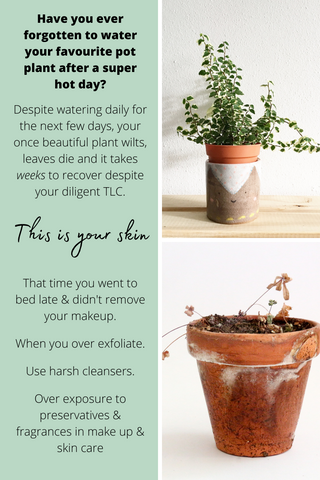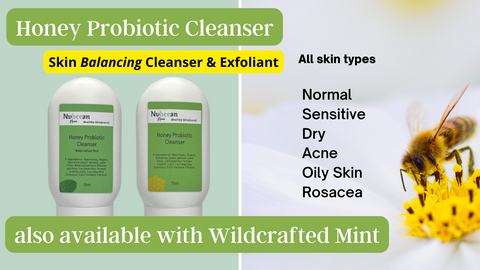Your Skin is a Garden: Tending Your Skin Microbiome
If your skin is a garden, what sort of skin microbiome garden lives on your skin? Is it covered with weeds? A thriving organic garden? Is it a barren wasteland?
Thinking of your skin as a garden will change your relationship with it. All of a sudden your skin starts to make sense.
Your skin is your body’s largest organ and has it’s own living, breathing ecosystem living upon it – your skin microbiome.
Too many people visualise and treat their skin as a bit like their kitchen bench. Skin analogies like 'bricks and mortar' when describing your skin's precious barrier don't help with understanding the true nature of your skin and it's microscopic ecosystem. Scrubbing or dousing your skin with harsh and damaging products will never produce healthy, resilient and beautiful skin. It will only cause imbalance, creating more redness, sensitivity, reactiveness, breakouts, oiliness and dryness.
Approaching your skin as a living garden rather than a sterile surface is the first step in forming a real connection with your skin and it's natural rhythms and cycles. Like any gardener knows, your skin's needs are constantly changing, they're never static. Your skin garden changes with the seasons, stress levels, hormonal fluctuations and diet.

Gut vs skin microbiome
The microbiome in your gut live in a lush paradise. They live in the warm, moist and protected environment of your digestive tract. These microbes even have their own version of Uber Eats – food is delivered straight to them every time you eat. They don’t have to go out hunting to survive. The microbes in your gut are diverse and abundant.
In comparison, living on your skin is like life in the Sahara Desert. However, if you’ve ever watched a David Attenborough or wild life documentary you’ll know that even in the desert, there is life, adapted to surviving in harsh and inhospitable environments. This is your skin microbiome. It’s not very diverse and each species has carved out its own little survival niche. It’s a highly competitive environment. Bacteria and microbes flock to the oasis areas of your skin that provide them with moisture and/or oil – face, upper back, armpits, groin, folds of elbows & knees as well as between your toes.
Your skincare choices are important. Ingredients found in them will influence your skin microbiome in a similar way to your diet helping to determine the make up of your gut microbiome. The bacteria and other microbes on your skin will adapt in response to the lotions and potions that you choose to apply each day.
Signs your skin garden is out of balance
It’s easy to spot if your skin microbiome or garden is out of balance. Signs and symptoms include:
- Skin prone to rashes and inflammation
- Sensitivity
- Reactive to skincare or environmental changes (weather, air conditioning etc)
- Acne, including adult acne (oil skin alone does not cause acne, there are plenty of people with oily skin who don’t experience acne and also people with dry/dehydrated skin who experience acne)
- Rosacea
- Psoriasis
- Eczema
- Dermatitis
Shop Pomegranate & Broccoli Sprout Mask
Regenerative agriculture for your skin
Regenerative agriculture is the wholistic practice that focuses on regeneration of top soil, increasing microbial and plant biodiversity, improving the water cycle, creating resilience to changes in the climate and generally enhancing and strengthening the health and vitality of the soil.
It encompasses other more well know agricultural methods such as biodynamic & organic farming practices and permaculture.
Regenerative Agriculture is also the perfect analogy for improving skin health through skin gardening. It's not difficult to imagine your skin's epidermis functioning like topsoil with trillions of microbes living upon it, and sheltering around hairs and within hair follicles.
When formulating all products in our Healthy Skin[care] range, my first question is always – how will this particular ingredient impact the skin microbiome and barrier. Our products are all designed to make your skin garden more resilient and balanced.
How do you tend your skin garden?
Do you practice Regenerative Agriculture? Are you applying skincare ingredients that are actively damaging your skin garden?
Over the next few weeks, I’ll be sharing articles that explore common skincare practices such as cleansing, toning and moisturising, and how they can influence your skin garden for better or for worse.
Want to learn more? Subscribe to our newsletter and receive updates in your inbox. SUBSCRIBE NOW
Keen to start adopting some Regenerative Agriculture practices for your skin and its garden? Check out our range of naturopath and nutritionist formulated Healthy Skin[care] products. BROWSE NOW
Not sure where to start? Get in contact with us, we’re happy to help guide you to become a better care taker of your skin garden. CONTACT US
![Healthy Skin[care] products that love your skin](https://cdn.shopify.com/s/files/1/0571/1613/1495/files/Healthy_skincare_ad_for_blog_1_480x480.png?v=1643199571)
Read more

 Skip to content
Skip to content


